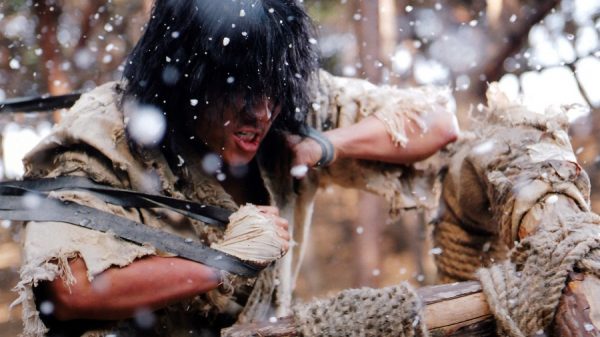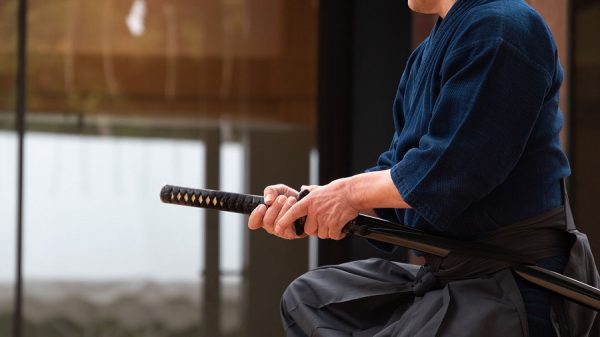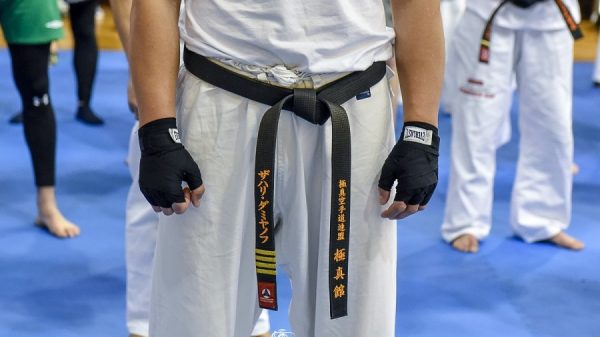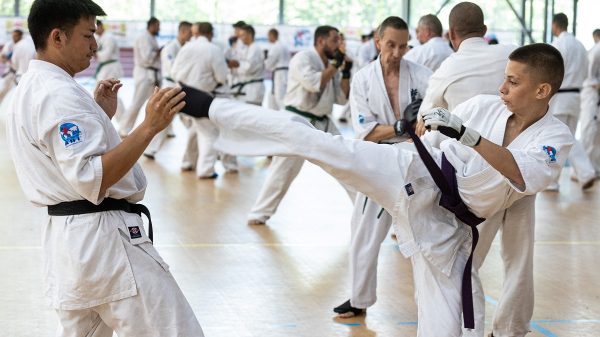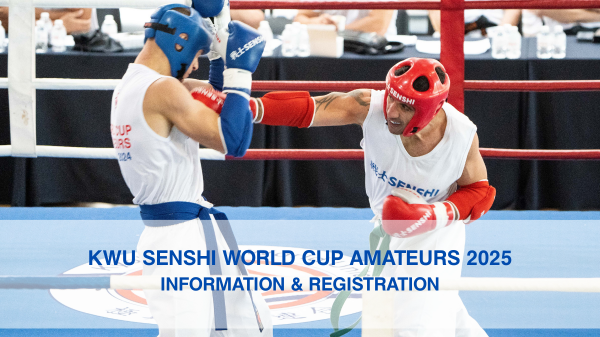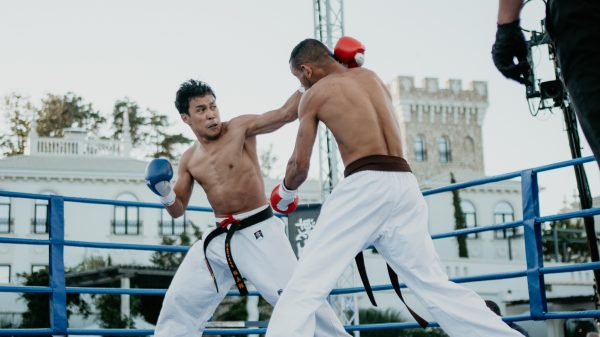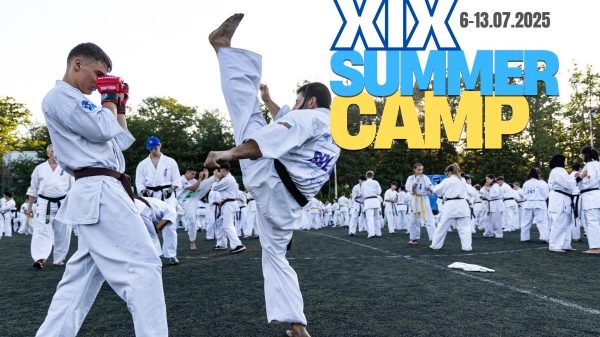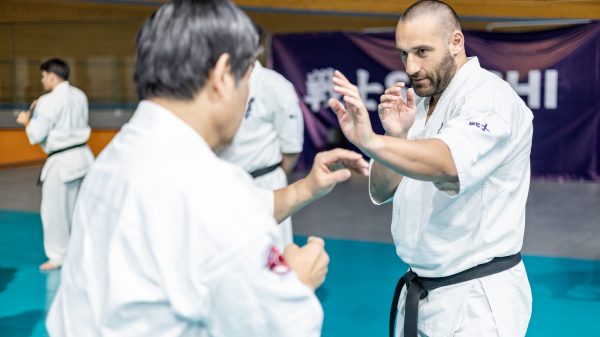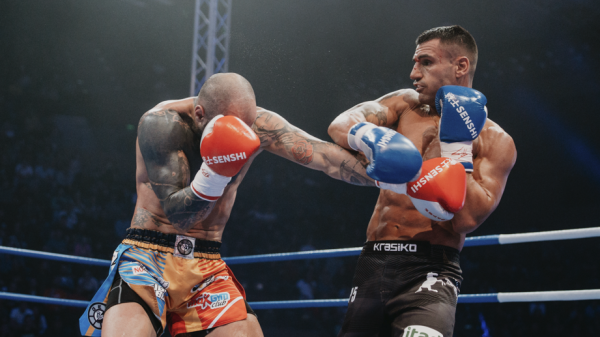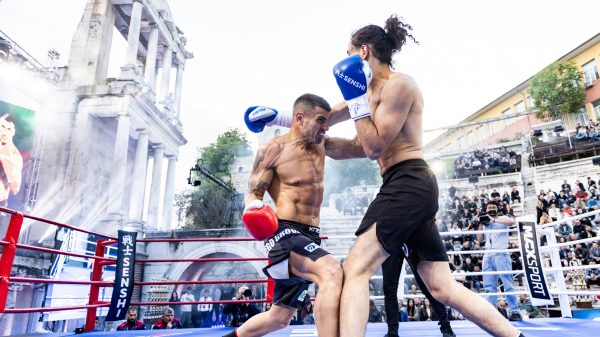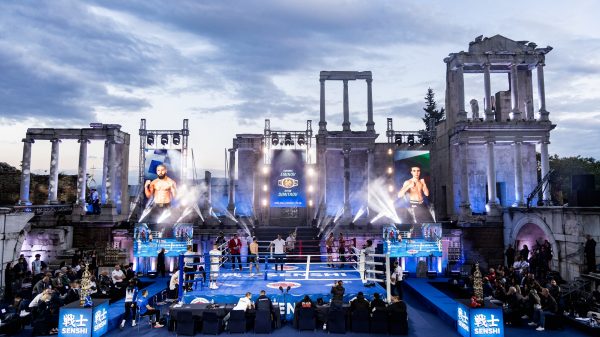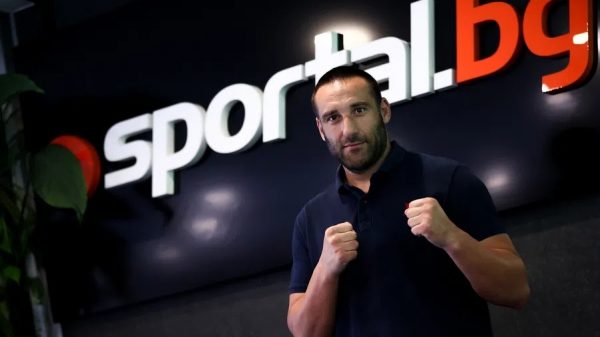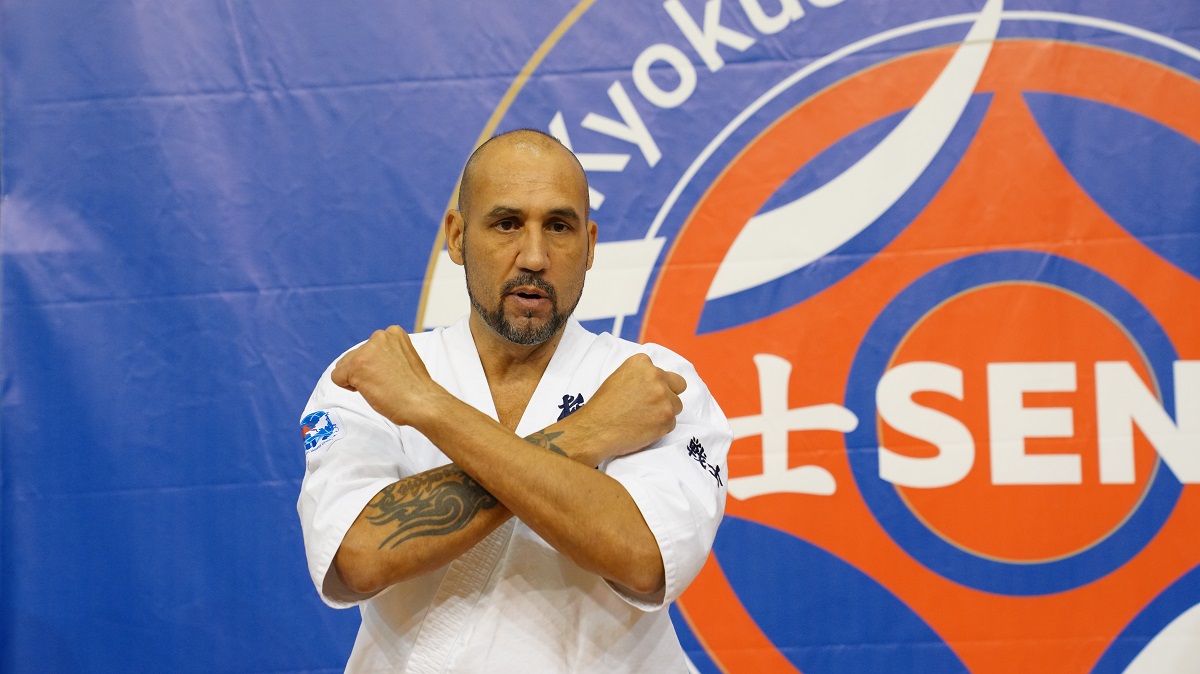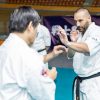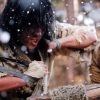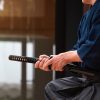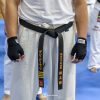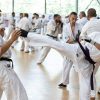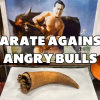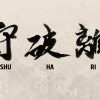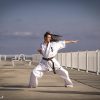One of the most unusual and hard things for both students and parents
to adjust to when beginning martial arts training is the etiquette in the dojo.
A dojo is a place of learning in which students as well as instructors place a great amount of emphasis on what can be referred to as traditional values. Most authentic and good dojo will have their Dojo Rules poster somewhere that is visible to both students and visitors in their dojo. To help new students / parents to the dojo understand how things are handled in the dojo it is important to cover several topics on this.
First understand what a dojo is. A Dojo is not a gym. It is not a place a student comes to the hang out or play. Students are there to train, improve and build self confidence, self discipline and perfect their martial art. It is also not a soccer field where parents can yell, complain and tell the coach what to do. In a good dojo there will be none of that and most parents struggle with this ideal but this is Karate, not kiddie sports. A Dojo is a sacred place full of etiquettes, tradition, sweat equity and improvement. It is held sacred to every student and black belt that trains there. Students and visitors will adhere to strict guidelines, treat the Sensei with respect at all times and help keep the dojo looking clean and in good repair. A Dojo is considered the home of the Sensei so it is important that students and visitors act accordingly.
In any good Karate dojo one of the most important rules is etiquette. We are human and we learn by trial and error. Many things in the dojo are forgiven when it comes to training but misbehaving, disrespect and unruliness are definitely not forgiven nor taken lightly. This rule applies to every student from the white belts to the black belts equally. In fact the higher rank a student becomes the more strict the guidelines for etiquette are held. It is the responsibility of each student to make sure those who follow behind them do so in proper fashion and with great respect to the etiquette rules of the dojo. It is important to note that corrections to one’s behavior comes from the top down, never from the bottom. In other words the Sensei is in charge and no one else should assume they can discipline a student without the Sensei’s permission.
ENTERING & EXITING THE DOJO
The first lesson a student will learn is proper placement of their shoes and how to enter the dojo. As we stated earlier the dojo is a very highly respected place. A new student will be lead to the entrance to the dojo by their Sempai (Senior). They will receive instruction on how to bow before entering and exiting the dojo. This is the first lesson as all Karate training begins and ends with respect, no exceptions. The next lesson is learning how to “bow in” before class and “bow out” after class. This can be both informal and formal depending on the class structure and what is taking place that day in the dojo. Regardless of the level of formality a student should always bow their best, most humble at all times.
To bow the student stands with their feet together, placing their hands at their sides. The bend at the waist (no hunching) to a 45 degree angle with their eyes looking downward. The only time we maintain eye contact is when we Kumite or do not trust the person across from us. Looking a senior rank in the eyes while bowing is very disrespectful. The second way we bow is in Seiza, or kneeling posture. To sit in seiza one steps backward to their right knee, followed the left knee. Males sit with their knees apart and females with their knees together. The belt is placed on the outside of the thighs. Hands rest on the thigh and the back is upright in posture. To bow your left hand touches the mat first and the right hand touches second forming a small triangle. You bend at the waist getting close to your hands but you do not have to touch them. Standing up from seiza is the reverse of kneeling…left comes up then right and stand up.
If you find yourself in a large group of students studying and class is over always be patient, allow senior ranks to exit first and then take your turn. Never cross in front of senior ranks or push, shove your way to leave the dojo. This is very rude, discourteous and will result in discipline measures by the Sensei. It is important to remember that every bow is done with the utmost courtesy and humbleness. Anything less is never acceptable.
ARRIVING LATE TO CLASSES
Yes we live in a hustle and bustle society but that never is an acceptable excuse for poor manners. Arriving late for scheduled things is considered disrespectful both inside and outside of the dojo. Proper manners dictate you arrive early, at least 10 minutes before class. You should have your required uniform and items for classes ready before the bow in of the day’s session. If, for some reason, you are to arrive late wait at the door until you are permitted to join in the session by the Sensei. Never just walk into the dojo because you may walk into a punch, kick or worse…a weapon strike. This is a safety measure, not a disciplinary one.
LINING UP FOR CLASSES
About a minute before class is set to begin the senior student will call out for everyone to line up. Lining up for classes consists of the junior ranks in the front and the most senior in the rear facing the front of the dojo where Sensei stands. It is also important to note that the lowest ranking student stands to the right in each line. If you are the same rank as others just get in line…it doesn’t matter who earn it first! Taking too long to get into line up position is not respectful and can result in the entire class being issued discipline by the Sensei. This happens mainly because you are wasting valuable class training time which is a major do not do in the dojo.
EVERYONE STARTS AT THE BOTTOM
Many people fail to understand this concept but in Karate there is NO other way for you to learn. Upon joining the dojo you will quickly find out that no one gets favored or special treatment. Even if the Chief Executive of a major business joins a dojo they will begin at the bottom. Whatever they have accomplished outside of the dojo has no bearing on their training and they are no better than each student standing next to them. Like I said everyone begins at the bottom in the dojo…no exceptions.
MOKUSO – PREPARING OF THE MIND
Mokuso is a meditation time before class and sometimes after class. During this procedure, which can be done kneeling or standing, students are to close their eyes, relax their breathing (in nose out mouth) and allow their mind to prepare to receive instruction. When done at the end of class the mind is to focus on retaining what the lessons of the day were about. During this time we learn to “quiet our mind”. This is a time to dispel negative thoughts, fears and to build our focus and attention.
DOJO KUN – YOUR CREED
Every good dojo has a Dojo Kun, better known as the student’s creed. These are guidelines on expected behavior and use of one’s skills they are studying in their Karate. While it may not be spoken during every class it is important that the student take time to memorize the Dojo Kun. When you break certain rules the Sensei will lead you to the Dojo Kun and have you re-read the line in reference to your actions. In some extreme cases you may be required to write a paragraph on the Dojo Kun before you can participate in training. Everyone, from a new student to the most senior black belt, is held to same standard of this creed…no exceptions at any time.
CLASSROOM ETIQUETTE
How you behave during classes will determine how you are taught in the dojo. Most new students get frustrated because they don’t understand the etiquette in the dojo right away. That’s alright and you will be reminded what is expected of you daily if you make a mistake. To help you understand how to “behave” during training here are some simple guidelines to follow:
- You must put aside all unrelated thoughts. Distracted minds cannot learn. When a Sensei is teaching your eyes must be fixated on them. This is the only way to learn properly.
- When solo training you must be completely focused on accomplishing the task Sensei instructed you in. There are no time outs, pauses or breaks unless the Sensei permits them. An example is Kata training. You are working on a single Kata. You have done the 5 times
- Sensei asked you to. You still have time left so you will keep doing the Kata until the Sensei allows you a break. Never do just the minimum as that is not how you improve.
- When training with a partner always bow before and after you train. Understand you are working with, not against one another. There is no place for ego or pride in training inside the dojo.
- Make sure your nails and toe nails are trimmed, your Gi is washed and in great shape. No one likes to work with a stinky partner and on top of that no one wants their finger or toenail torn off.
- When you hear a Sensei yell the command to stop do so immediately. Listen and watch everything your Sensei is doing as they teach you. Learn to see the finer details of what the Sensei is teaching and then seek to implement it yourself to improve.
- Never interrupt the Sensei. Never be rude or ill tempered with the Sensei and most of all never challenge ANY Sensei. These are just proper and common morals of dealing with one’s seniors.
- There are no challenge matches in the dojo. That is on television and in movies. A challenge match issued in the dojo will result in removal of the student / parent / visitor in a very harsh and harmful manner.
- Always swallow your pride and ego. Everyone is here to learn and work together. Your training is not about just you so treat each student as you want to be treated at all times.
UNDERSTAND HOW TO PROPERLY TALK TO YOUR SENSEI
A Sensei is much more than just a teacher but the one thing no student, parent or visitor will ever be allowed to do is talk back to them. Karate training is a privilege, not a right. A Sensei is always, both inside and outside of the dojo, treated with the utmost respect. If you truly have such an issue with your Sensei that you feel you have to disrespect them make sure you keep your calm, politely ask to speak to them in private and be on time when they schedule you for a meeting. The Sensei role requires them to push you to extreme levels in your training…so much so that you may get very mad and frustrated at them but never forget, that in Karate, EVERYTHING is a TEST. If the Sensei is really busy it is very rude to expect them to drop everything for you…this is something a student will never do.
Addressing your Sensei outside of the dojo seems to cause much confusion. The Sensei is always the Sensei first, even if you quit training, they are treated as such. A good Sensei will never demand you refer to them as Sensei outside the dojo but it is only proper to do so. Parents and students should never call the Sensei by their first name. It is highly unlikely that the Sensei will correct you if you do but it is not proper. You do not have to bow to your Sensei outside of the dojo but many times we do out of respect…but that is never required unless you feel the need to. You and your Sensei may become friends but it is important that you remember they are always Sensei first and your friend second. Keep this in mind so you don’t get upset when your Sensei calls you on improper etiquette issues.
FINISH THE CLASS – END OF TRAINING TIME
When we finish class you will hear the command to line up and just like we began class do so quickly and smartly. We will bow out the same manner as we bowed in. Also never forget to allow the Seniors that are at the entrance to leave before you. You do not have to wait for them to get to the door but if they are there before you it is only proper to wait your turn to leave. Always remember to thank your Sensei for the lessons of the class before you leave. Just rushing around and leaving is very rude…no matter what excuse you come up with for it.
CLEANING THE DOJO
While we really don’t do this today as much as we used to it is important to remember that every single student is responsible to keep the dojo clean and nice looking. If something is broken and you have the means to help out by fixing then do so. At the end of the night make sure you have all your equipment and things with you. Leaving water bottles and trash lay around the dojo expecting the Sensei to clean up after you is highly disrespectful and never tolerated. If the dojo is not taken care of by the students then it is not uncommon for the Sensei to have all the students spend their class time cleaning it. This is PART of your training when it comes to learning humility, respect for others and their things and the Karate Way.
EARNING RESPECT
In Karate respect is earned from your Seniors and the Sensei, not the other way around. Those who have come before you are the ones you have to earn respect from and you will give respect to. If there is ever an issue with a senior in the dojo you are to bring it to the attention of the Sensei. Students, regardless of the rank they earned, are only human and ego, pride do get in the way at times. Sensei will give them a reminder action so they can remember the responsibility that comes with being a senior student in the dojo. When you understand and follow the etiquette of the dojo, train hard and attend classes as required you will earn the respect of those that matter. No student has ever earned a black belt in a good school without understanding these simple guidelines to their training.
In closing it is important that you understand the dojo is stepping into Okinawa. The training is demanding because that is what it takes to become a black belt. Sure you can always quit and find another school who may just give you one or is less strict but that doesn’t mean you are a good black belt…that just means you are selfish and couldn’t be taught. Let me repeat that…quitting just to get a black belt at a school that sells them doesn’t make you a real black belt…it makes you not ready to truly earn one.
On a side note it is important to remember that the Sensei should lead by example. They should not be a bully, they should be understanding somewhat and should have your best interests in mind but more often than not people fail to remember that a Sensei is there to push you, pull out your best and demand the best from you. Without this level of training you aren’t learning Karate, you aren’t improving and you definitely will not be ready to face that BAD GUY who wants to take your head off in a real fight. The best advice I have ever had was “Damatte Keiko” which means “Shut up and train”. Just because I didn’t agree with something that happened in the dojo or how I was made to feel doesn’t mean I would just quit. Everything is a test…and I grew from it, learned from it and became a Sensei because of it.
by Franz Karate


